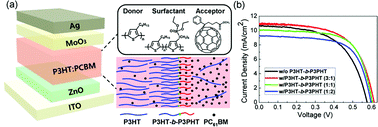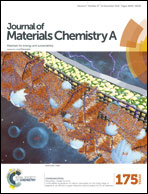Toward high efficiency organic photovoltaic devices with enhanced thermal stability utilizing P3HT-b-P3PHT block copolymer additives†
Abstract
Organic photovoltaics (OPVs) have drawn an extensive amount of attention due to their low cost, processibility and flexibility. However, a cell based on a blend of poly(3-hexylthiophene) (P3HT) and [6,6]-phenyl-C61-butyric acid methyl ester (PC61BM) has a limited power conversion efficiency (PCE) due to the short exciton diffusion length of ∼10 nm. We address this issue by designing a series of all-conjugated diblock copolymers, poly(3-hexylthiophene)-b-poly(3-(6-diethylphosphonatohexyl)thiophene) (P3HT-b-P3PHT), intended for use as additives to improve the performance of P3HT:PC61BM-based photovoltaic devices. The PCE of the devices improved from 3.30% to 4.03% with the addition of P3HT-b-P3PHT (3 : 1). The thermal stability of devices with P3HT-b-P3PHT additives improved significantly relative to that of the P3HT:PC61BM reference device, where the devices including a copolymer with a higher P3PHT content exhibited a better thermal stability. It was found that the fill factor (FF) could be regulated by simply varying the block ratio of P3HT-b-P3PHT and played a crucial role in improving both the PCE and the thermal stability. The P3HT-b-P3PHT diffused at the P3HT:PC61BM interface, improved the miscibility between P3HT and PC61BM, optimized the nanoscale morphology of the photoactive layer, and reduced the active layer roughness, all of which improved the FF and thus contributed to an improvement in device performance.



 Please wait while we load your content...
Please wait while we load your content...